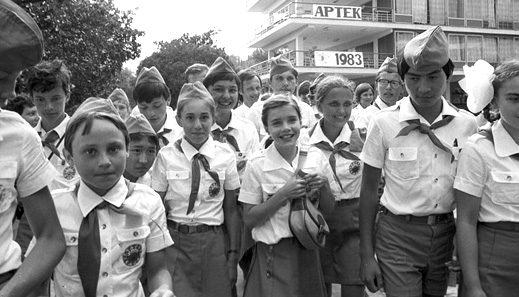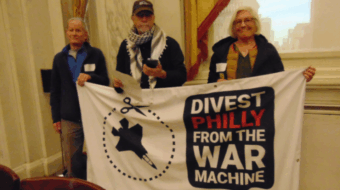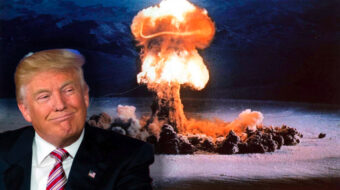
(history.com) On this day in 1983, the Soviet Union releases a letter that Russian leader Yuri Andropov wrote to Samantha Smith, an American fifth-grader from Manchester, Maine, inviting her to visit his country. Andropov’s letter came in response to a note Smith had sent him in December 1982, asking if the Soviets were planning to start a nuclear war. At the time, the United States and Soviet Union were Cold War enemies.
While not seen as an environmental issue at the time, nuclear weapons pose the single biggest threat to the Earth’s environment, scientists warned in 2006. The Guardian reported: In a new study of the potential global impacts of nuclear blasts, an American team found even a small-scale war would quickly devastate the world’s climate and ecosystems, causing damage that would last for more than a decade.
Coincidentally, at least nine nuclear tests were performed on April 25:
1961 – France performs nuclear test at Reggane Proving Grounds Algeria
1962 – US resumes above ground nuclear testing, at Christmas Island
1971 – USSR performs nuclear test at Eastern Kazakh/Semipalitinsk USSR
1973 – US performs nuclear test at Nevada Test Site
1975 – USSR performs underground nuclear test
1977 – USSR performs nuclear test at Eastern Kazakh/Semipalitinsk USSR
1981 – More than 100 workers are exposed to radiation during repairs of a nuclear power plant in Tsuruga, Japan.
1982 – Great Britain performs nuclear test at Nevada Test Site
1982 – USSR performs nuclear test at Eastern Kazakh/Semipalitinsk USSR
In the early 1980s, nuclear war worries were high. President Ronald Reagan, a passionate anti-communist, had dubbed the Soviet Union the “evil empire” and called for massive increases in U.S. defense spending to meet the perceived Soviet threat. In his public relations duel with Reagan, known as the “Great Communicator,” Andropov, who had succeeded longtime Soviet leader Leonid Brezhnev in 1982, assumed a folksy, almost grandfatherly approach that was incongruous with the negative image most Americans had of the Soviets.
Andropov’s letter said that Russian people wanted to “live in peace, to trade and cooperate with all our neighbors on the globe, no matter how close or far away they are, and, certainly, with such a great country as the United States of America.” In response to Smith’s question about whether the Soviet Union wished to prevent nuclear war, Andropov declared, “Yes, Samantha, we in the Soviet Union are endeavoring and doing everything so that there will be no war between our two countries, so that there will be no war at all on earth.” Andropov also complimented Smith, comparing her to the spunky character Becky Thatcher from “The Adventures of Tom Sawyer” by Mark Twain.
Smith, born June 29, 1972, accepted Andropov’s invitation and flew to the Soviet Union with her parents for a visit. Afterward, she became an international celebrity and peace ambassador, making speeches, writing a book and even landing a role on an American television series. In February 1984, Yuri Andropov died from kidney failure and was succeeded by Konstantin Chernenko. The following year, in August 1985, Samantha Smith died tragically in a plane crash at age 13.
Teresa Albano contributed to this article.
Photo: Samantha Smith, center, visits the Soviet Union in 1983 at an Artek Pioneer camp (Wikipedia).










